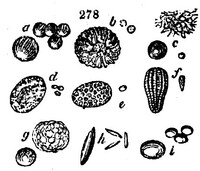1613. Nearly all insects are oviparous, or produced from eggs (fig. 278.); but the eggs of some are hatched within the body (as the viviparous flesh-fly), and the young are produced in a living state; the generality of insects deposit their eggs in secure places, either above or beneath the earth: many are sometimes laid at one period. The eggs in a few species increase in size before they are hatched. The young provide for their own subsistence as soon as they are hatched. The forms of the eggs of insects are much diversified: as examples of these, in their natural as well as magnified size, we refer to those of the Phalï¾µ'na nupta (fig. 278. b), brown-tailed moth (c), currant moth (d), common gooseberry moth (e), cabbage butterfly, (f), spider (g), house cricket (h), and cockchafer (i). The eggs of snails and slugs (a) are known from those of insects by being much larger; they are of a bluish white, with a considerable degree of transparency, and are found in small clusters beneath the ground. The period required for the hatching of eggs is various; in some species this process takes place in a few days, while with others it is not accomplished until the following year.

